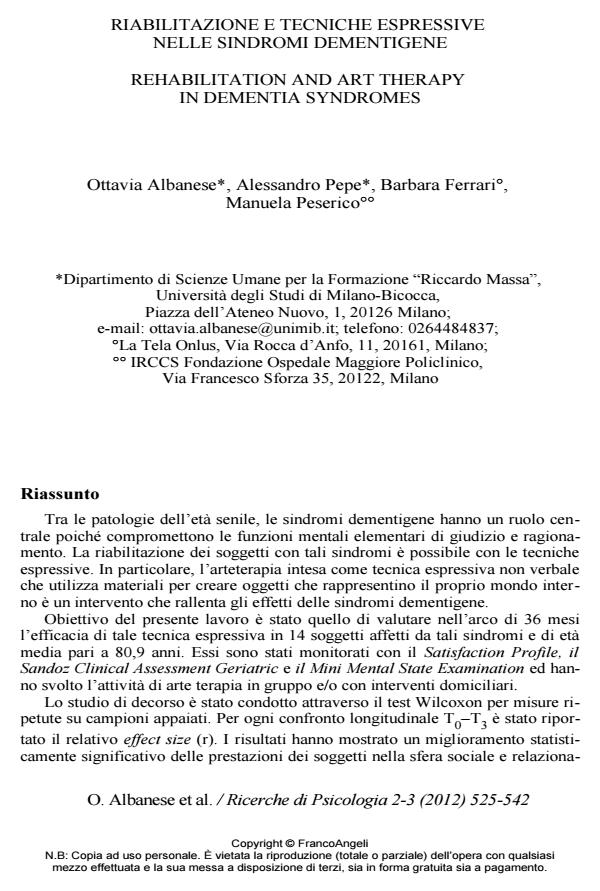Rehabilitation and art therapy in dementia syndromes
Journal title RICERCHE DI PSICOLOGIA
Author/s Ottavia Albanese, Alessandro Pepe, Barbara Ferrari, Manuela Peserico
Publishing Year 2013 Issue 2012/2-3
Language Italian Pages 18 P. 525-542 File size 227 KB
DOI 10.3280/RIP2012-002024
DOI is like a bar code for intellectual property: to have more infomation
click here
Below, you can see the article first page
If you want to buy this article in PDF format, you can do it, following the instructions to buy download credits

FrancoAngeli is member of Publishers International Linking Association, Inc (PILA), a not-for-profit association which run the CrossRef service enabling links to and from online scholarly content.
Among senile pathologies, dementia syndromes play a central role, since they damage basic mental functions of judgment and reasoning. The rehabilitation of patients affected by such syndromes is possible through expressive techniques. In particular, Art-Therapy, as a non-verbal expressive technique based on the use of different materials to create objects representative of one’s internal state, can slow down the effects of dementia syndromes. This work aimed to assess the efficacy - in a period of 36 months - of an art-therapy intervention on 14 patients with such syndromes (mean age = 80,9 years). Patient monitoring was carried out by administering: Satisfaction Profile, Sandoz Clinical Assessment Geriatric and Mini Mental State Examination. The art-therapy intervention took place in small groups and/or in domestic sessions. The medical study was investigated with the Wilcoxon repeated measures test for paired samples. The effect size (r) was reported for each longitudinal comparison T0–T3. Results showed a statistically significant improvement of subjects’ socio-relational performances, particularly in the dimensions of psychological functionality, social and affective behavior. Such progress could be ascribable to the group modality of work, which allows reciprocal support among the participants. Furthermore, the re-activation of creative skills, linked to previous subjects’ abilities, stimulated a decrease of the deterioration phenomena, also in domestic interventions.
Keywords: Rehabilitation, art therapy, dementia syndromes.
Ottavia Albanese, Alessandro Pepe, Barbara Ferrari, Manuela Peserico, Riabilitazione e tecniche espressive nelle sindromi dementigene in "RICERCHE DI PSICOLOGIA " 2-3/2012, pp 525-542, DOI: 10.3280/RIP2012-002024